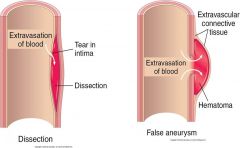Japanese neurosurgeons reported the case of A 55-year-old man who presented with progressive pain and expanding swelling in his right neck. He had no history of trauma or infectious disease. The patient had undergone chiropractic manipulations once in a month and the last manipulation was done one day before the admission to hospital.
On examination by laryngeal endoscopy, a swelling was found on the posterior wall of the pharynx on the right side. The right piriform fossa was invisible. CT revealed hematoma in the posterior wall of the right oropharynx compressing the airway tract. Aneurysm-like enhanced lesion was also seen near the right common carotid artery. Ultrasound imaging revealed a fistula of approximately 1.2 mm at the posterior wall of the external carotid artery and inflow image of blood to the aneurysm of a diameter of approximately 12 mm. No dissection or stenosis of the artery was found. Jet inflow of blood into the aneurysm was confirmed by angiography. T1-weighted MR imaging revealed presence of hematoma on the posterior wall of the pharynx and the aneurysm was recognized by gadolinium-enhancement.
The neurosurgeons performed an emergency operation to remove the aneurysm while preserving the patency of the external carotid artery. The pin-hole fistula was sutured and the wall of the aneurysm was removed. Histopathological assessment of the tissue revealed a pseudoaneurysm (also called a false aneurism), a collection of blood that forms between the two outer layers of an artery.

The patient was discharged after 12 days without a neurological deficit. Progressively growing aneurysm of the external carotid artery is caused by various factors and early intervention is recommended. Although, currently, intravascular surgery is commonly indicated, direct surgery is also feasible and has advantages with regard to pathological diagnosis and complete repair of the parent artery.
The relationship between the pseudoaneurysm and the chiropractic manipulations seems unclear. The way I see it, there are the following three possibilities:
- The manipulations have causally contributed to the pseudo-aneurysm.
- They have exacerbated the condition and/or its symptoms.
- They are unrelated to the condition.
If someone is able to read the Japanese full text of this paper, please let us know what the neurosurgeons thought about this.

The readers should keep in mind that chiropractic as a profession is not legislated in Japan. Thus, anyone in Japan can claim to do “chiropractic”.
The intelligent readers don’t need to be patronized. And legislation of chiroquackery in the US has allowed Activator and similar adjusting-guns, SOT blocking and drop-tables to be billed as manipulation. Legislation is often driven by lobbyists using conniving and pseudo-science arguments to convince gullible legislators of things which ain’t the case. Voila’ chiroquackery is a licensed “profession” in all 50 states.
@MK
The US is a basket case Michael with wildly differing jurisdictions, regulation, scope of practice between states and very little chance of national standards, registration and/or regulation. This applies to your profession, physiotherapy, as much as chiropractic. Each state is a silo protecting the turf of local institutions. A national regulator with standards enforced across all professions like AHPRA here in Australia would he highly unlikely given American’s resistance to expanding central government/regulators powers.
Japan is the wild west where anything goes. One benefit of the global financial crisis was that 20 odd dodgy colleges set up by non-chiropractors went to the wall. Is this practitioner from one of these colleges? Don’t know and I would also like to read the full paper.